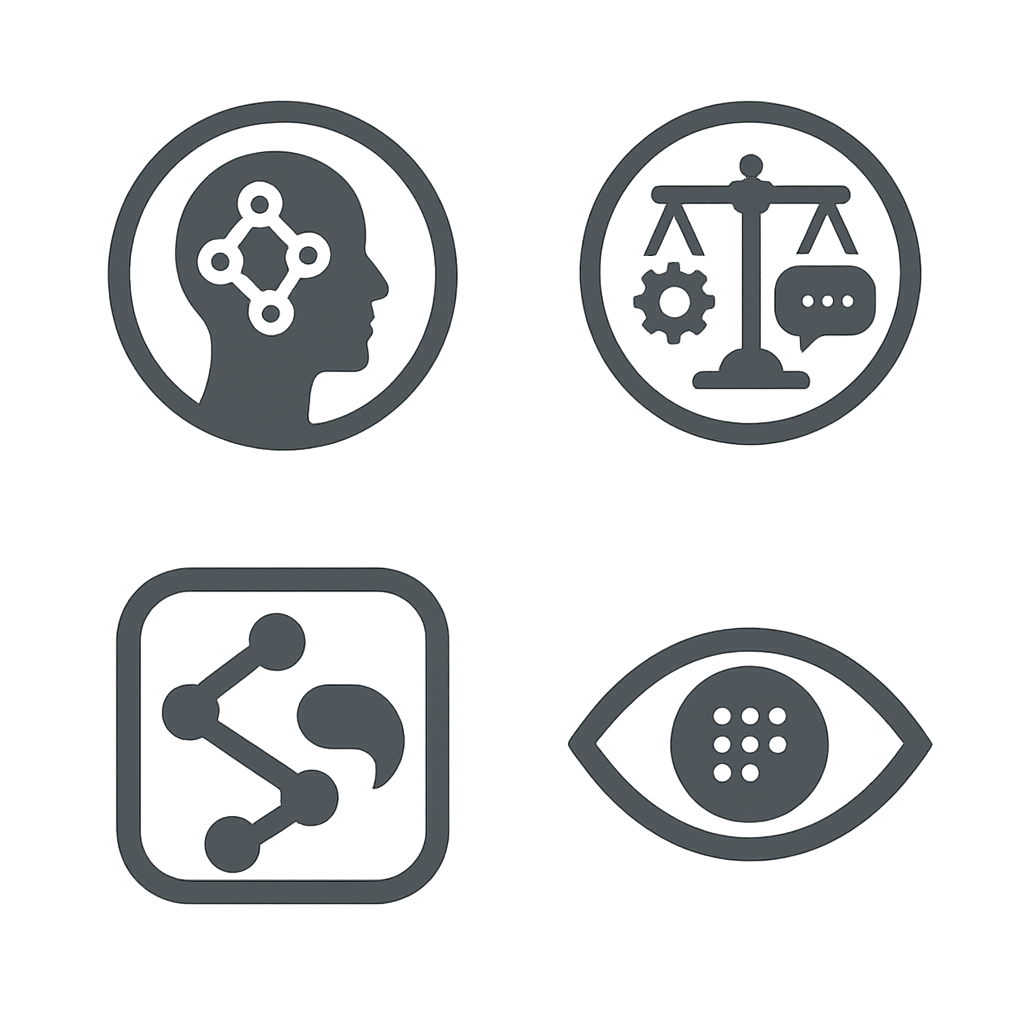Teaser
I read AI with Bourdieu as a set of platform fields where capitals—data, code, compute, money, cultural clout—meet habitus inside algorithmic classification. Symbolic power works best when sorting feels “natural” and unremarkable—until a shock produces hysteresis and suddenly exposes the game and its rules.
Introduction
Bourdieu gives me a grammar for seeing AI beyond “users” and “features.” A field is a structured space of positions (labs, platforms, creators, regulators, annotators, advertisers) locked in struggle over stakes; agents bring convertible forms of capital (economic, social, cultural, symbolic—and today also compute and data); their dispositions (habitus) meet the field’s rules (doxa, illusio). Recommendation engines, benchmarks, and trust-and-safety taxonomies are classification devices that confer recognition and consecrate winners. The research task is to map these fields, follow capital conversions, and surface the misrecognitions that make power look like merit.
Six Bourdieuian lenses for AI
1) Fields, not markets. Each platform (search, social, streaming, app stores, LLM ecosystems) is a field with incumbent and challenger positions, gatekeepers (APIs, app review, safety policy), and stakes (reach, rent, reputation). What looks like “competition” is a structured struggle shaped by rules and history.
2) New capitals & conversion rates. Compute capital (access to GPUs/TPUs), data capital (rights, pipelines, user graphs), code capital (model weights, infra), and attention capital (audiences) convert into money and symbolic authority. Fields are defined by who sets the exchange rate between these capitals.
3) Habitus meets interface. Prompt fluency, benchmark literacy, “dashboard sense” are forms of cultural capital. Unequal schooling and professional socialization shape who feels “at home” in AI-mediated work—and who pays a tax of uncertainty.
4) Doxa, illusio, and symbolic violence. Doxa is the taken-for-granted (“the algorithm is neutral,” “trending is what people want”). Illusio is the felt investment in the game (shipping, chasing metrics). When classifications quietly devalue some speakers or styles, misrecognition turns sorting into symbolic violence.
5) Hysteresis. When a field changes faster than habitus—after a policy or model update—creators, teachers, or workers misread the new rules and lose ground. Watching adaptation lags reveals the hidden structure of the game.
6) Consecration devices. Benchmarks, leaderboards, blue checks, “safety certifications,” and citation counts act like academies and salons once did: they legitimate and distribute prestige. Study who designs these devices and whose judgment they encode.
Three applications
Creator economies. Recommenders convert social and cultural capital into attention capital under shifting rules (format, length, “brand safety”). A Bourdieuian audit traces who can convert attention back into money and standing—and who is locked out by classification.
Hiring & productivity AI. Résumé parsers and productivity scores naturalize certain careers, schools, and styles of writing/speaking as “fit.” Ask which capitals are being proxied (class, language, networks) and how habitus is re-sorted as merit.
Science & knowledge work. Benchmarks and SOTA claims are consecration rituals. Map the field (conferences, labs, reviewers, compute holders) and measure how prestige and compute capital co-produce “the frontier.”
Toolkit for students
- Field map: Chart positions (incumbents/challengers), gatekeepers, and stakes for one platform domain.
- Capital ledger: Inventory compute, data, code, money, social ties, and reputation; show where conversions happen (e.g., API access → distribution).
- Doxa inventory: Write down the “obvious truths” participants rarely question; test them against counter-cases.
- Hysteresis diary: Track a policy/model update; log who adapts, who loses, and which tacit skills stopped working.
- Consecration tracker: List badges, lists, and metrics that bestow legitimacy; identify whose judgment they institutionalize.
- Misrecognition probe: Reveal a hidden classification (labels, thresholds) to participants and observe what changes.
Guiding questions
- Who sets the exchange rates among data, compute, code, attention, and money in this field?
- Which dispositions (habitus) the interface rewards—and which it taxes?
- Where does “that’s just how it is” (doxa) conceal a redesignable rule?
- Which consecration devices decide careers—and who gets to contest them?
- What shocks produce hysteresis, and how can we protect the vulnerable during the shift?
Design & policy takeaways
- Visibility justice: Audit exposure and discovery across groups and styles; rotate “review juries” and diversify consecration devices.
- Contestable classification: Publish label definitions, thresholds, and appeal routes; include counter-datasets curated by affected communities.
- Capital access: Lower barriers to compute/data via public or pooled resources; document who receives privileged API or distribution access and why.
- Hysteresis buffers: Announce rule changes early; provide grace periods, tooling support, and conversion guides for displaced practices.
Literature (APA, with links)
Bourdieu, P. (1977). Outline of a Theory of Practice. Cambridge University Press. Publisher page (CUP).
Bourdieu, P. (1984). Distinction: A Social Critique of the Judgement of Taste. Harvard University Press. Publisher page (HUP).
Bourdieu, P. (1990). The Logic of Practice. Stanford University Press. Publisher page (Stanford).
Bourdieu, P. (1991). Language and Symbolic Power. Harvard University Press. Publisher page (HUP).
Bourdieu, P. (1993). The Field of Cultural Production. Columbia University Press. Publisher page (Columbia).
Bourdieu, P. (1998). Practical Reason: On the Theory of Action. Stanford University Press. Publisher page (Stanford).
Bourdieu, P. (1998). On Television. The New Press. Publisher page (The New Press).
Sociological Brainteasers (for students)
- Field map in 60 minutes: Pick one platform (search, short-video, app store, LLM plug-ins). Who are the incumbents, challengers, and gatekeepers? What are the core stakes and which rules (policy, API, metrics) shape the struggle?
- Capital exchange rate: In your chosen field, where do compute, data, code, money, and attention convert into one another? Identify one “privileged conversion point” (e.g., API access → distribution) and who controls it.
- Habitus vs. interface: Observe two creators/users with different backgrounds doing the same task. Which dispositions (prompt fluency, benchmark literacy, “dashboard sense”) the interface rewards—and which it taxes?
- Doxa detector: List five “obvious truths” people in this field rarely question (e.g., “the algorithm is neutral”). For each, propose a concrete counter-case or redesign.
- Symbolic violence probe: Find one classification (label/threshold) that quietly devalues styles, dialects, or groups. How is the devaluation misrecognized as merit or safety?
- Hysteresis watch: Track a policy or model update for two weeks. Who adapts fast, who loses ground, and which tacit skills stopped working?
- Consecration audit: List the badges, lists, and metrics that bestow legitimacy (leaderboards, “safety certifications,” blue checks). Whose judgment do they institutionalize, and how contestable are they?
- Design a buffer: For one harmful shock you observed, propose a “hysteresis buffer” (grace periods, migration tools, fund for displaced practices) and a metric for success.
Publishable version of the prompt
“Please write a post for our series ‘What would sociologist X say about AI & Society?’ focusing on Pierre Bourdieu. Begin with a short teaser. Use Bourdieu’s core concepts—field, forms of capital (economic, social, cultural, symbolic; extend to compute, data, code, and attention), habitus, doxa and illusio, symbolic violence, hysteresis, and consecration devices—to analyze platform ecosystems. Include (1) an introduction situating AI as structured fields, (2) 5–6 conceptual lenses, (3) three short applications (e.g., creator economies; hiring/productivity AI; science & benchmarks), (4) a practical student toolkit, (5) design & policy takeaways, and (6) an APA ‘Literature (with links)’ section to primary Bourdieu texts (publisher pages preferred). Format for WordPress with H2/H3 headings and no inline links in the body.”


Leave a Reply